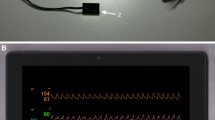Abstract
Objective
The utility of continuous intra-arterial blood gas analysis (CBGA) with combined electrochemical and optode sensors has been demonstrated. More recently, a pure optode sensor with a changed sensing element architecture has become available. The aim was to determine the measurement accuracy and long-term stability of the new sensor.
Design
A prospective explorative study was performed. Simultaneous measurements of intermittent blood gas analyses (IBGA) (ABL 610, Radiometer, Copenhagen) and CBGA (Diametrics Medical, High Wycombe, Bucks., UK) were compared using Bland-Altman analysis.
Patients
Twenty-five patients admitted to the ICU and requiring mechanical ventilation for an expected minimum of about 96 h were included.
Results
Mean monitoring time was 106.1 (range 15–231) hours. Bias and precision for PO2 were −0.2 kPa (1%)±1.8 kPa (9.5%); PCO2: 0.03 kPa (0.6%)±0.44 kPa (9.3%); pH: −0.001 (0.01%)±0.04 (0.45%). The sensor showed no change of measurement characteristics during 4 days of measurement. However, in 69 cases continuous monitoring was interrupted (reversible sudden drops of PO2 measurement) possibly caused by thrombotic deposition and/or sensor bending and accidental sensor retraction.
Conclusions
The precision and bias of the PCO2- and pH-sensing elements were in line with the findings of the older sensor technology. The possibility that the PO2 optode could offer greater accuracy than the older technology is suggested by comparisons with results reported in previous studies. No sensor drift occurred during long-term measurement over more than 4 days.




Similar content being viewed by others
References
Sasse SA, Chen PA, Mahutte CK (1994) Variability of arterial blood gas values over time in stable medical ICU patients. Chest 106:187–193
Hatherill M, Tibby SM, Durward A, Rajah V, Murdoch IA (1997) Continuous intra-arterial blood-gas monitoring in infants and children with cyanotic heart disease. Br J Anaesth 79:665–667
Venkatesh B, Pigott DW, Fernandez A, Hendry SP (1996) Continuous measurement of arterial blood gas status during total hip replacement: a prospective study. Anaesth Intensive Care 24:334–341
Green GE, Hassell KT, Mahutte CK (1987) Comparison of arterial blood gas with continuous intra-arterial and transcutaneous PO2 sensors in adult critically ill patients. Crit Care Med 15:491–494
Mahutte CK (1998) On-line arterial blood gas analysis with optodes: current status. Clin Biochem 31:119–130
Mahutte CK (1994) Continuous intra-arterial blood gas monitoring. Intensive Care Med 20:85–86
Venkatesh B, Clutton-Brock TH, Hendry SP (1994) Continuous measurement of blood gases using a combined electrochemical and spectrophotometric sensor. J Med Eng Technol 18:165–168
Venkatesh B, Clutton-Brock TH, Hendry SP (1995) Evaluation of the Paratrend 7 intravascular blood gas monitor during cardiac surgery: comparison with the C4000 in-line blood gas monitor during cardiopulmonary bypass. J Cardiothorac Vasc Anesth 9:412–419
Vretzakis G, Papaziogas B, Matsaridou E, Vasiliadou G, Papadopoulos G, Patsialas C, Kostopoulou F (2000) Continuous monitoring of arterial blood gases and pH during intraoperative rapid blood administration using a Paratrend sensor. Vox Sang 78:158–163
Weiss IK, Fink S, Harrison R, Feldman JD, Brill JE (1999) Clinical use of continuous arterial blood gas monitoring in the pediatric intensive care unit. Pediatrics 103:440–445
Haller M, Kilger E, Briegel J, Forst H, Peter K (1994) Continuous intra-arterial blood gas and pH monitoring in critically ill patients with severe respiratory failure: a prospective, criterion standard study. Crit Care Med 22:580–587
Larson CP Jr (1996) Continuous arterial blood gas monitoring: a technology in transition. Intensive Care Med 22:1141–1143
Venkatesh B, Hendry SP (1996) Continuous intra-arterial blood gas monitoring. Intensive Care Med 22:818–828
Mantha S, Roizen MF, Fleisher LA, Thisted R, Foss J (2000) Comparing methods of clinical measurement: reporting standards for bland and altman analysis. Anesth Analg 90:593–602
Morgan C, Newell SJ, Ducker DA, Hodgkinson J, White DK, Morley CJ, Church JM (1999) Continuous neonatal blood gas monitoring using a multiparameter intra-arterial sensor. Arch Dis Child Fetal Neonatal Ed 80:F93–98
Pappert D, Rossaint R, Lewandowski K, Kuhlen R, Gerlach H, Falke KJ (1995) Preliminary evaluation of a new continuous intra-arterial blood gas monitoring device. Acta Anaesthesiol Scand [Suppl 107]:67–70
Zaugg M, Lucchinetti E, Zalunardo MP, Zumstein S, Spahn DR, Pasch T, Zollinger A (1998) Substantial changes in arterial blood gases during thoracoscopic surgery can be missed by conventional intermittent laboratory blood gas analyses. Anesth Analg 87:647–653
Zollinger A, Spahn DR, Singer T, Zalunardo MP, Stoehr S, Weder W, Pasch T (1997) Accuracy and clinical performance of a continuous intra-arterial blood-gas monitoring system during thoracoscopic surgery. Br J Anaesth 79:47–52
Ishikawa S, Makita K, Nakazawa K, Amaha K (1998) Continuous intra-arterial blood gas monitoring during oesophagectomy. Can J Anaesth 45:273–276
Coule LW, Truemper EJ, Steinhart CM, Lutin WA (2001) Accuracy and utility of a continuous intra-arterial blood gas monitoring system in pediatric patients. Crit Care Med 29:420–426
Abraham E, Gallagher TJ, Fink S (1996) Clinical evaluation of a multiparameter intra-arterial blood-gas sensor. Intensive Care Med 22:507–513
Medicare MaCP (1992) Regulations Implementing the Clinical Laboratory Improvement Amendments of 1988 (CLIA '88). Federal Register 7002–7186
Mahutte CK, Sassoon CS, Muro JR, Hansmann DR, Maxwell TP, Miller WW, Yafuso M (1990) Progress in the development of a fluorescent intravascular blood gas system in man. J Clin Monit 6:147–57
Venkatesh B, Clutton Brock TH, Hendry SP (1994) A multiparameter sensor for continuous intra-arterial blood gas monitoring: a prospective evaluation. Crit Care Med 22:588–594
Acknowledgments
This study was supported by a cooperation contract between Philips Medical Systems (Böblingen, Germany) and the Department of Anesthesiology and Critical Care Medicine of the University of Halle-Wittenberg, Germany.
Author information
Authors and Affiliations
Corresponding author
Rights and permissions
About this article
Cite this article
Menzel, M., Soukup, J., Henze, D. et al. Experiences with continuous intra-arterial blood gas monitoring: precision and drift of a pure optode-system. Intensive Care Med 29, 2180–2186 (2003). https://doi.org/10.1007/s00134-003-1962-1
Received:
Accepted:
Published:
Issue Date:
DOI: https://doi.org/10.1007/s00134-003-1962-1




